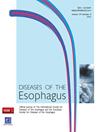740. RABEPRAZOLE PROTECTS REFLUX ESOPHAGITIS DUE TO BILE IN RAT MODEL
IF 2.3
3区 医学
Q3 GASTROENTEROLOGY & HEPATOLOGY
引用次数: 0
Abstract
Aims we studied the effect of proton pump inhibitor(PPI)(Rabeprazole) therapy on esophageal bile reflux in esophagitis after total gastrectomy. (Methodology) Sixteen 8-week old male Wistar rats were underwent total gastrectomy and esophagoduodenostomy to induce esophageal reflux of biliary and pancreatic juice. In 5 rats the sham operation induced a midline laparatomy alone (Sham). One week following surgery, they were treated with saline (Control) (n=8) PPI (Rabeprazole)(n=8)(30mg/kg/day) ip for 2 weeks. 3 weeks after operation, all rats were killed and the esophagus was evaluated histologically. Esophageal injury was evaluated by macroscopic, microscopic findings and expression of COX2 and PGE2. We performed the measurement of bile acid in the esophageal lumen and common bile duct. Results At 3 weeks after surgery, duodenal reflux induced esophageal erosions and ulcer formation. The macroscopic ulcer score and microscopic ulcer length were significantly reduced by PPI. The enhanced expression of COX2 and PGE2 in the control group was also markedly inhibited in the PPI group. Really, there is no difference between control group and PPI group in bile acid concentration from the common bile duct. PPI does not inhibit the secretion of bile acid from the common bile duct. But, the bile acid activity in the esophageal lumen was significantly increased in the control group, and this increase was significantly inhibited in the PPI group. Conclusion These results indicate that bile acid, which is inhibited by Rabeprazole, plays an important role in the mucosal damage induced by duodenal reflux.740.雷贝拉唑对大鼠胆汁引起的反流性食管炎有保护作用
目的 我们研究了质子泵抑制剂(PPI)(雷贝拉唑)治疗对全胃切除术后食管炎食管胆汁反流的影响。(方法)对16只8周大的雄性Wistar大鼠进行全胃切除和食管十二指肠造口术,以诱导食管胆汁和胰液反流。5 只大鼠仅接受了中线腹腔切口假手术(Sham)。术后一周,用生理盐水(对照组)(n=8)、PPI(雷贝拉唑)(n=8)(30 毫克/千克/天)ip 治疗 2 周。手术 3 周后,处死所有大鼠并对食管进行组织学评估。食管损伤通过宏观和微观检查结果以及 COX2 和 PGE2 的表达进行评估。我们对食管腔和胆总管中的胆汁酸进行了测量。结果 手术后 3 周,十二指肠反流导致食管糜烂和溃疡形成。PPI 能显著降低宏观溃疡评分和微观溃疡长度。PPI 组也明显抑制了对照组中 COX2 和 PGE2 表达的增强。对照组和 PPI 组的胆总管胆汁酸浓度确实没有差异。PPI 并不抑制胆总管胆汁酸的分泌。但是,对照组食管腔内胆汁酸活性明显增加,而 PPI 组明显抑制了这种增加。结论 这些结果表明,被雷贝拉唑抑制的胆汁酸在十二指肠反流引起的粘膜损伤中起着重要作用。
本文章由计算机程序翻译,如有差异,请以英文原文为准。
求助全文
约1分钟内获得全文
求助全文
来源期刊

Diseases of the Esophagus
医学-胃肠肝病学
CiteScore
5.30
自引率
7.70%
发文量
568
审稿时长
6 months
期刊介绍:
Diseases of the Esophagus covers all aspects of the esophagus - etiology, investigation and diagnosis, and both medical and surgical treatment.
 求助内容:
求助内容: 应助结果提醒方式:
应助结果提醒方式:


